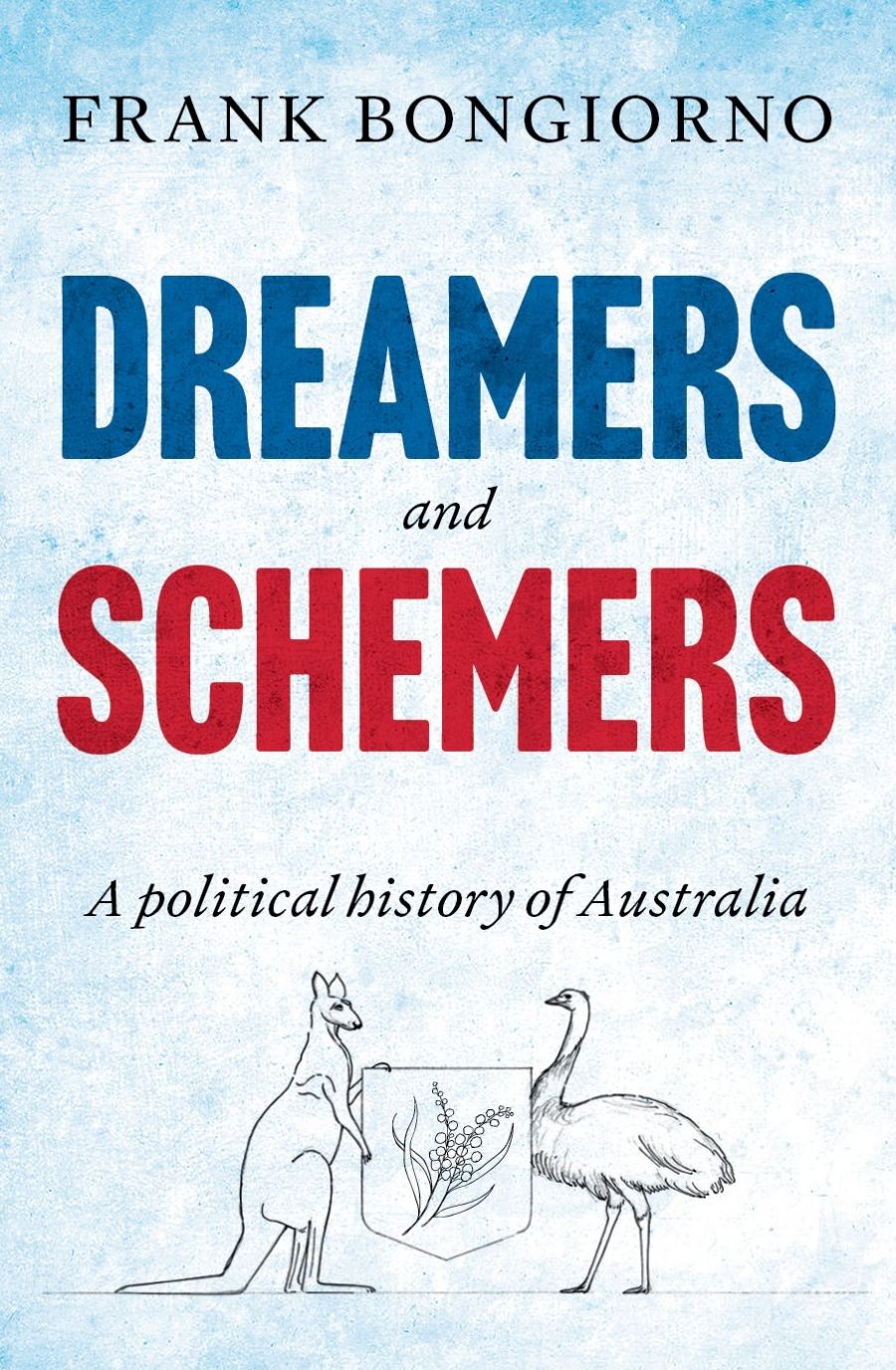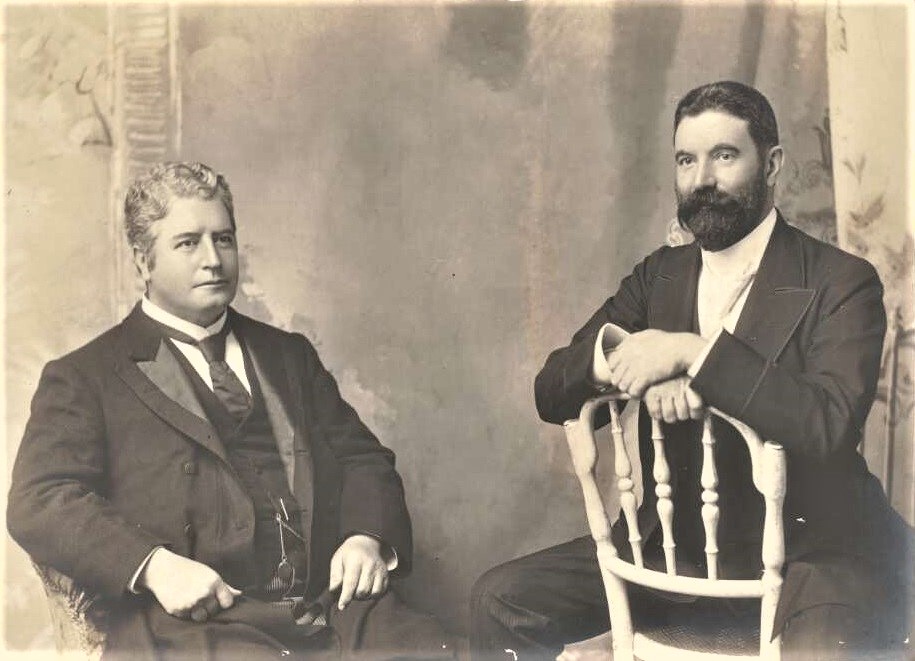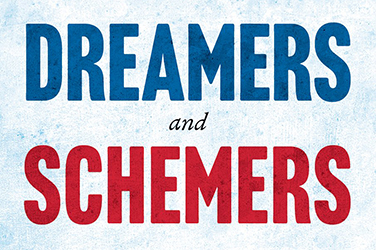
- Free Article: No
- Contents Category: Politics
- Review Article: Yes
- Article Title: Master of his material
- Article Subtitle: Frank Bongiorno’s new political history
- Online Only: No
- Custom Highlight Text:
'The history of the Victorian Age,’ wrote Lytton Strachey a century ago, ‘will never be written: we know too much about it.’ Instead, he continued, he would ‘row out over that great ocean of material, and lower down into it, here and there, a little bucket, which will bring up to the light of day some characteristic specimen … to illustrate rather than to explain’ (Eminent Victorians, 1918).
- Article Hero Image (920px wide):

- Article Hero Image Caption: Edmund Barton and Alfred Deakin, 1898 (National Library of Australia PIC/5491 via Wikimedia Commons)
- Featured Image (400px * 250px):

- Alt Tag (Featured Image): James Walter reviews 'Dreamers and Schemers: A political history of Australia' by Frank Bongiorno
- Book 1 Title: Dreamers and Schemers
- Book 1 Subtitle: A political history of Australia
- Book 1 Biblio: La Trobe University Press, $39.99 pb, 472 pp
- Book 1 Readings Link: https://www.booktopia.com.au/dreamers-and-schemers-frank-bongiorno/book/9781760640095.html
Dreamers and Schemers, Bongiorno’s inspired title, highlights his attention to the visionaries along with the rough and ready practices of political insiders – from the idealists, such as Alfred Deakin, Edmund Barton, and Gough Whitlam; to the schemers, such as George Reid, John Forrest, and Graham Richardson; as well as the outright criminal (Eddie Obeid), the delusional (Scott Morrison), and the pragmatic (Anthony Albanese). This is a handful of the headline names, but many other lesser-known figures are given due attention. Bongiorno’s account of figures involved in local elections in the nineteenth century echoes the riotous comedy, occasional violence, and chaos of those sardonically fictionalised in Dickens’s Pickwick Papers. The tone is darker, though, as Bongiorno turns his attention to more recent instances of deception, rorting, and corruption in the parties of the late twentieth and early twenty-first centuries, and the decline in political trust this precipitated.
The political scientist Alan Davies once summarised W.K. Hancock’s influential Australia (1930) as having shown that ‘Australians were apt to demand too much of politics, and that they zig-zagged between cynical resignation and mad reforming zeal’. So, he suggested, we should pay close attention to ‘mobilising’ periods of reform and their consequences, both planned and unintended. This is, perhaps unwittingly, exactly how Bongiorno frames his narrative, focusing on episodes of political renewal in the 1850s, 1890s, 1940s, and 1980s – and the periods of ‘cynical resignation’ that often followed as the dreams these encouraged were pared back by economic, social, and institutional realities. While acutely aware of those who have been left out and left behind by Australian practices of politics and development, Bongiorno heartens us all by maintaining the faith that, since change was achieved in the past by ‘political leaders, activists, intellectuals and movements who refused to be merely practical … refusing to accept injunctions merely to tinker rather than transform’, it can happen again.
Unlike the authors of most ‘national’ histories, preoccupied by Canberra, national parliament, and prime ministers, Bongiorno pays as much attention to state politics, the distinctive political cultures that prevailed in different regions, and the historical contexts in which they arose, as he does to the federal sphere. It is a welcome broadening of our perceptions of how circumstances and decisions most pertinent to one’s own locale have developed and will sharpen appreciation of the particular roles of different levels of government.
Historians and political scientists with specialist knowledge of particular periods will find much to debate in Bongiorno’s account; we can expect much scribbling in the margins. A great deal is seen to hinge upon elections, both federal and state, somewhat to the detriment of what Judith Brett and Anthony Moran identified as Ordinary People’s Politics (2006), or of how community activism and advocacy coalitions arise and impact the political class. Bongiorno, I think, remains too leader-centric – we learn a lot about specific politicians and periods, but not enough about the people behind the scenes, whose research, community links, lobbying, activism, and public sector leverage shaped what their political masters thought possible and influenced what was decided. Arguably, however, in a long book, satisfying such quibbles would require too much diversion into details that would disrupt its narrative momentum.
Of more significance are areas in which Bongiorno embraces admirable objectives but fails to deliver quite what appears to be promised. For instance, the threads of Aboriginal activism and policy, feminist history, and measured party analysis are rightly incorporated into his narrative. Yet, the treatment of the pre-settlement politics of Aboriginal Australians, though well sourced, is brief and schematic; the examination of colonial wars and frontier massacres and their centrality in colonial politics is insufficient given how largely they have come to figure in contemporary thinking and research about current politics; and while the key episodes of Aboriginal (and settler) activism in more recent decades are registered, along with consequent legislative change (and paternalistic intervention), they never assume quite the moral heft that Bongiorno appears to intend.
It is questionable whether understanding of distinctive party views (and hence policy commitments) is furthered by bald assertions such as ‘Howard was committed to increasing inequality’, surely something he would deny. Arguably, Bongiorno’s analysis indicates that Labor itself, with its 1980s reforms, paved the way for introducing ‘state supported self-reliance [which] often did a poor job of protecting the most vulnerable’. Some reflection on unintended consequences might have been apposite. Feminist historians are likely to think that their revelation of women’s role in ‘creating the nation’ is not adequately represented. And while the importance of Julia Gillard and female state premiers is recognised, some might cavil at a discussion of minor parties that ignores the roles and national profiles of Natasha Stott Despoja and Meg Lees. The difficulty is that Bongiorno’s default position is to see politics through the lens of leaders and formal institutions, still disproportionately the domain of white men and professionals, even though he explicitly identifies the patterns of demographic change that render this unrepresentative.
Such reservations, however, can be offset by the sheer ambition of Bongiorno’s new political history. His astonishing range, commitment to identifying historical instances of a better politics leavened by robust common sense, and the wit, imagination, and stylish proficiency of his argument are seductive. Bongiorno understands his audience. It is a book to enjoy. If it provokes debate and argument – leaving one thinking – as well as satisfying a thirst for political knowledge, so much the better.


Comments powered by CComment